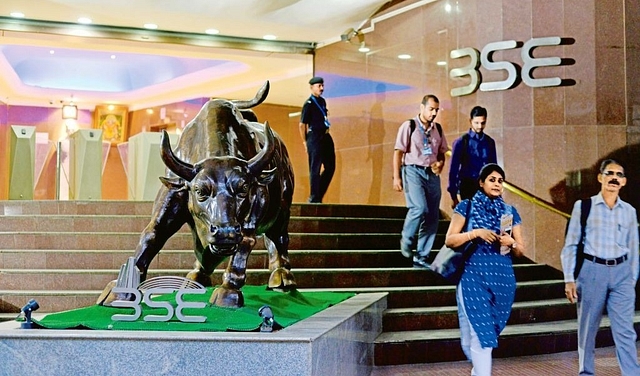
Is Sensex Too Hot To Handle? Time For Caution, But No Need To Write Off 2018 As Yet
Since the uptick in the economy is just beginning, with the IIP at a two-year high in November, and exports also beginning to pick up, one can reasonably expect earnings growth to rise in fiscal 2018-19.
Have Indian stocks become overvalued in the flood of liquidity that came into the markets in 2017, when the Sensex and Nifty rose 29 per cent?
The answer is yes and no. Yes, because valuations are close to a bubble zone, with price-earnings ratios now hovering around 27. The market usually starts reversing around this level. The market capitalisation of the Bombay Stock Exchange is closing in on the country’s gross domestic product (GDP) for 2017-18: market cap is at over Rs 155 lakh crore against advance GDP estimates of Rs 166 lakh crore.
Whenever stock market valuation looks set to cross the GDP figure, it is time for caution.
Uday Kotak, vice-chairman of Kotak Mahindra Bank, recently rang alarm bells when he told The Financial Express that there is a bubble risk, since savings are flowing into a “few hundred stocks”, and many of these are small and mid-cap companies, whose governance standards are unknown. He said: “while we are in the right direction, I always worry about excesses. Here we have got a wonderful situation where massive amounts of savings are moving to financial savings. Within the financial savings space, (money flows) into mutual funds, unit-linked schemes of insurance companies and directly into the equity markets. Money is coming through a broad funnel and it’s going into a narrow pipe… massive amount of Indian savers’ money is now going into a few hundred stocks.”
However, while Kotak’s worries are valid, there are other factors that mitigate the problem.
One is that stocks have merely discounted future good news. Since the uptick in the economy is just beginning, with the IIP at a two-year high in November, and exports also beginning to pick up, one can reasonably expect earnings growth to rise in fiscal 2018-19. This could make valuations seem more reasonable.
The second reason for cautious optimism is liquidity. Stock valuations primarily depend on the money flowing into stocks, as Kotak himself pointed out. The big difference between previous booms and the one in 2017 is that the latter was not driven by hot money – foreign institutional investment (FII). It was largely driven by domestic retail flows, often made through SIPs (systematic investment plans).
Perhaps for the first time ever, it is not skittish FIIs driving stocks up and down. It is the work of ordinary investors. According to data provided by the Association of Mutual Funds in India (AMFI), in the April-December period of 2017, there were 1.88 crore SIPs operational, and they collected more than Rs 47,000 crore, with December figures alone crossing Rs 6,222 crore.
More important, in December 2017, inflows into new equity schemes were higher than that for income funds, at Rs 5,582 crore against Rs 4,502 crore. Taking new and existing equity schemes, equity got Rs 38,263 crore, while income schemes got Rs 50,700 crore. But add equity linked savings schemes and exchange-traded funds (ETFs), and you reach a figure of Rs 44,280 crore. Add balanced funds, which are a mix of equity and debt, and the total reaches Rs 56,031 crore.
The above calculation is slightly misleading and an over-simplification, since ETFs are of various kinds (not just equity), and balanced funds also carry a large component of debt, but then even income funds invest in equity. Broadly, the above figures suggest that the retail investor, using SIPs, ELSS and ETFs, is investing nearly half her money in equity.
More important, in the whole of 2017, FIIs invested a net of Rs 51,252 crore in equity, which gives you a monthly average of Rs 4,271 crore. The Indian retail investor now invests more in equity than FIIs.
If this liquidity surge through equity funds and SIPs continues, one can expect the markets to stay reasonably stable, though 2018 is likely to be a stockpickers’ market rather than one with a broadbased rise.
Kotak’s worry that the stock market rise is concentrated in a few hundred stocks is largely the result of mutual funds doing the investing rather than individual investors. Whenever institutional stock pickers invest on behalf of retail savers, you will get this concentration since experts will tend to converge on well-researched stocks.
However, there is one more point to make: the fact that investment is concentrated on a few hundred stocks is not surprising given the Indian economy’s size. The US economy, which is nearly 10 times larger than India, trades just about 2,800 stocks daily on the New York Stock Exchange, and possibly 4,000 in all exchanges overall. If frequency of trading indicates the quality of the stocks traded, India’s catchment of a few hundred stocks is what would qualify as appropriate for a country one-tenth the size of the US.
This is not to say Kotak’s caution is unwarranted, just that money is going into broadly the stocks worth investing in. Whether the valuations are too high or just about right will depend on earnings growth in 2018. And, of course, the budget and the direction of Indian politics takes in a year filled with assembly elections.